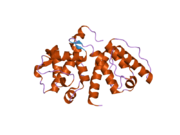Biology:Actinin alpha 4
 Generic protein structure example |
Alpha-actinin-4 is a protein that in humans is encoded by the ACTN4 gene.[1]
Alpha actinins belong to the spectrin gene superfamily which represents a diverse group of cytoskeletal proteins, including the alpha and beta spectrins and dystrophins. Alpha actinin is an actin-binding protein with multiple roles in different cell types. In nonmuscle cells, the cytoskeletal isoform is found along microfilament bundles and adherens-type junctions, where it is involved in binding actin to the membrane. In contrast, skeletal, cardiac, and smooth muscle isoforms are localized to the Z-disc and analogous dense bodies, where they help anchor the myofibrillar actin filaments. This gene encodes a nonmuscle, alpha actinin isoform which is concentrated in the cytoplasm, and thought to be involved in metastatic processes. Mutations in this gene have been associated with focal and segmental glomerulosclerosis.[1]
Interactions
Actinin alpha 4 has been shown to interact with PDLIM1,[2][3] Sodium-hydrogen exchange regulatory cofactor 2,[4] Collagen, type XVII, alpha 1,[5] CAMK2A,[6] CAMK2B,[6] MAGI1[7] and TRIM3.[8]
See also
References
- ↑ 1.0 1.1 "Entrez Gene: ACTN4 actinin, alpha 4". https://www.ncbi.nlm.nih.gov/sites/entrez?Db=gene&Cmd=ShowDetailView&TermToSearch=81.
- ↑ Rual, Jean-François; Venkatesan Kavitha; Hao Tong; Hirozane-Kishikawa Tomoko; Dricot Amélie; Li Ning; Berriz Gabriel F; Gibbons Francis D et al. (Oct 2005). "Towards a proteome-scale map of the human protein-protein interaction network". Nature (England) 437 (7062): 1173–8. doi:10.1038/nature04209. PMID 16189514. Bibcode: 2005Natur.437.1173R.
- ↑ Vallenius, T; Luukko K; Mäkelä T P (Apr 2000). "CLP-36 PDZ-LIM protein associates with nonmuscle alpha-actinin-1 and alpha-actinin-4". J. Biol. Chem. (UNITED STATES) 275 (15): 11100–5. doi:10.1074/jbc.275.15.11100. ISSN 0021-9258. PMID 10753915.
- ↑ Kim, Jae Ho; Lee-Kwon Whaseon; Park Jong Bae; Ryu Sung Ho; Yun C H Chris; Donowitz Mark (Jun 2002). "Ca(2+)-dependent inhibition of Na+/H+ exchanger 3 (NHE3) requires an NHE3-E3KARP-alpha-actinin-4 complex for oligomerization and endocytosis". J. Biol. Chem. (United States) 277 (26): 23714–24. doi:10.1074/jbc.M200835200. ISSN 0021-9258. PMID 11948184.
- ↑ Gonzalez, A M; Otey C; Edlund M; Jones J C (Dec 2001). "Interactions of a hemidesmosome component and actinin family members". J. Cell Sci. (England) 114 (Pt 23): 4197–206. ISSN 0021-9533. PMID 11739652.
- ↑ 6.0 6.1 Walikonis, R S; Oguni A; Khorosheva E M; Jeng C J; Asuncion F J; Kennedy M B (Jan 2001). "Densin-180 forms a ternary complex with the (alpha)-subunit of Ca2+/calmodulin-dependent protein kinase II and (alpha)-actinin". J. Neurosci. (United States) 21 (2): 423–33. doi:10.1523/JNEUROSCI.21-02-00423.2001. PMID 11160423.
- ↑ Patrie, Kevin M; Drescher Andrew J; Welihinda Ajith; Mundel Peter; Margolis Ben (Aug 2002). "Interaction of two actin-binding proteins, synaptopodin and alpha-actinin-4, with the tight junction protein MAGI-1". J. Biol. Chem. (United States) 277 (33): 30183–90. doi:10.1074/jbc.M203072200. ISSN 0021-9258. PMID 12042308.
- ↑ El-Husseini, A E; Kwasnicka D; Yamada T; Hirohashi S; Vincent S R (Jan 2000). "BERP, a novel ring finger protein, binds to alpha-actinin-4". Biochem. Biophys. Res. Commun. (UNITED STATES) 267 (3): 906–11. doi:10.1006/bbrc.1999.2045. ISSN 0006-291X. PMID 10673389.
Further reading
- "Treatment of Haemophilus aphrophilus endocarditis with ciprofloxacin.". J. Infect. 24 (3): 317–20. 1992. doi:10.1016/S0163-4453(05)80037-4. PMID 1602151.
- "Alpha-actinin and vinculin in human neutrophils: reorganization during adhesion and relation to the actin network.". J. Cell Sci.. 101 ( Pt 2): 403–14. 1992. PMID 1629252.
- "An interaction between alpha-actinin and the beta 1 integrin subunit in vitro.". J. Cell Biol. 111 (2): 721–9. 1990. doi:10.1083/jcb.111.2.721. PMID 2116421.
- "Activation of human neutrophils induces an interaction between the integrin beta 2-subunit (CD18) and the actin binding protein alpha-actinin.". J. Immunol. 151 (7): 3795–807. 1993. PMID 8104223.
- "A locus for inherited focal segmental glomerulosclerosis maps to chromosome 19q13.". Kidney Int. 53 (2): 282–6. 1998. doi:10.1046/j.1523-1755.1998.00828.x. PMID 9461087.
- "Actinin-4, a novel actin-bundling protein associated with cell motility and cancer invasion.". J. Cell Biol. 140 (6): 1383–93. 1998. doi:10.1083/jcb.140.6.1383. PMID 9508771.
- "Functional interaction between the cytoplasmic leucine-zipper domain of HIV-1 gp41 and p115-RhoGEF.". Curr. Biol. 9 (21): 1271–4. 1999. doi:10.1016/S0960-9822(99)80511-9. PMID 10556093.
- "The human non-muscle alpha-actinin protein encoded by the ACTN4 gene suppresses tumorigenicity of human neuroblastoma cells.". Oncogene 19 (3): 380–6. 2000. doi:10.1038/sj.onc.1203310. PMID 10656685.
- "BERP, a novel ring finger protein, binds to alpha-actinin-4.". Biochem. Biophys. Res. Commun. 267 (3): 906–11. 2000. doi:10.1006/bbrc.1999.2045. PMID 10673389.
- "Mutations in ACTN4, encoding alpha-actinin-4, cause familial focal segmental glomerulosclerosis.". Nat. Genet. 24 (3): 251–6. 2000. doi:10.1038/73456. PMID 10700177.
- "CLP-36 PDZ-LIM protein associates with nonmuscle alpha-actinin-1 and alpha-actinin-4.". J. Biol. Chem. 275 (15): 11100–5. 2000. doi:10.1074/jbc.275.15.11100. PMID 10753915.
- "The amino-terminal domain of the B subunit of vacuolar H+-ATPase contains a filamentous actin binding site.". J. Biol. Chem. 275 (41): 32331–7. 2000. doi:10.1074/jbc.M004795200. PMID 10915794.
- "Densin-180 forms a ternary complex with the (alpha)-subunit of Ca2+/calmodulin-dependent protein kinase II and (alpha)-actinin.". J. Neurosci. 21 (2): 423–33. 2001. doi:10.1523/JNEUROSCI.21-02-00423.2001. PMID 11160423.
- "A point mutation in the alpha-actinin-4 gene generates an antigenic peptide recognized by autologous cytolytic T lymphocytes on a human lung carcinoma.". Cancer Res. 61 (10): 4078–83. 2001. PMID 11358829.
- "Association of tyrosine phosphatase SHP-2 with F-actin at low cell densities.". J. Biol. Chem. 276 (31): 29479–84. 2001. doi:10.1074/jbc.M104428200. PMID 11382784.
- "Raver1, a dual compartment protein, is a ligand for PTB/hnRNPI and microfilament attachment proteins.". J. Cell Biol. 155 (5): 775–86. 2002. doi:10.1083/jcb.200105044. PMID 11724819.
- "Binding of gelsolin domain 2 to actin. An actin interface distinct from that of gelsolin domain 1 and from ADF/cofilin.". Eur. J. Biochem. 268 (23): 6165–75. 2002. doi:10.1046/j.0014-2956.2001.02574.x. PMID 11733011.
- "Interactions of a hemidesmosome component and actinin family members.". J. Cell Sci. 114 (Pt 23): 4197–206. 2002. PMID 11739652.
- "Each actin subunit has three nebulin binding sites: implications for steric blocking.". Curr. Biol. 12 (5): 383–8. 2002. doi:10.1016/S0960-9822(02)00678-4. PMID 11882289.
- "Ca(2+)-dependent inhibition of Na+/H+ exchanger 3 (NHE3) requires an NHE3-E3KARP-alpha-actinin-4 complex for oligomerization and endocytosis.". J. Biol. Chem. 277 (26): 23714–24. 2002. doi:10.1074/jbc.M200835200. PMID 11948184.
External links
- Human ACTN4 genome location and ACTN4 gene details page in the UCSC Genome Browser.




